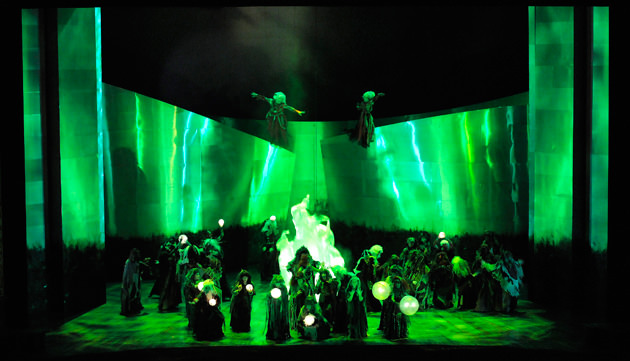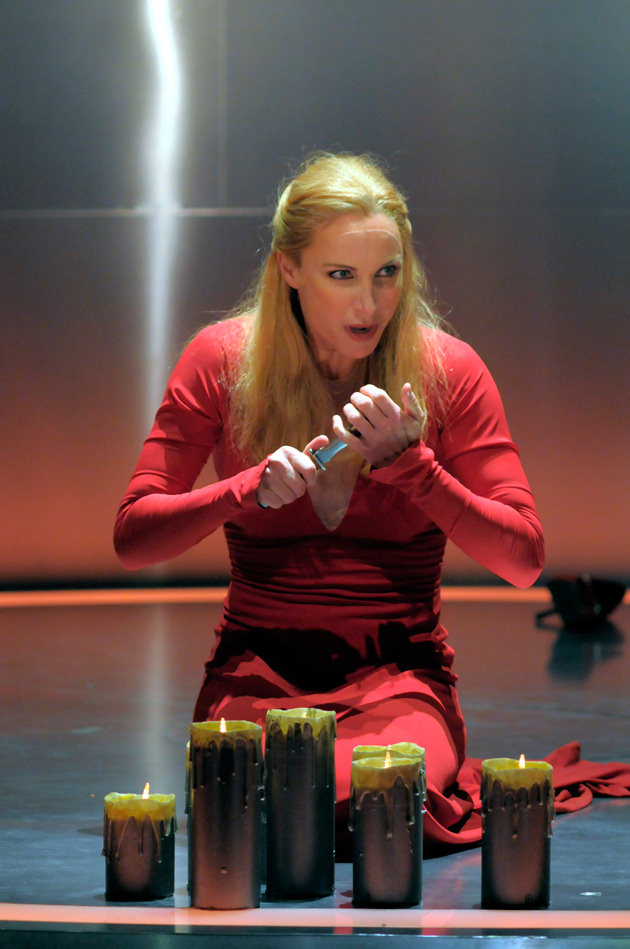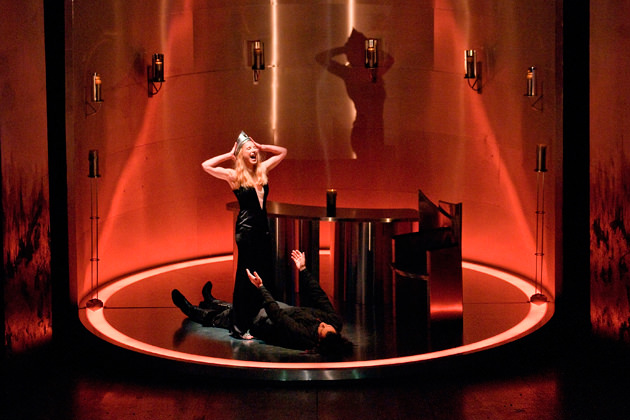This month at the Lyric Opera of Chicago there is a production of Verdi’s Macbeth to knock your socks off. Barbara Gaines, the director of the Chicago Shakespeare Theater at Navy Pier, has done spectacular productions of Shakespeare’s plays, but this is her first opera work, and she has thought deeply and creatively about the text, both verbal and musical. Take the scene where the murdered Banquo’s ghost shows up at the castle banquet. Macbeth, out of guilt, sees the ghost, but no one else does. How do you stage that? Sometimes the ghost comes up from the trap door while the diners are looking elsewhere. Sometimes he shimmers behind scrims, or is set off by weird lighting that the banqueters are not supposed to see. Shakespeare and Verdi make it clear that the actor playing Banquo should reappear, but spectrally. As the 20th-century literary critic Arthur Quiller-Couch put it:
Who sees the ghost? Not the company. Not even Lady Macbeth. Those who see it are Macbeth and you and I. Those into whom it strikes terror…those whom it accuses are Macbeth and you and I. And what it accuses is what, of Macbeth, you and I are hiding in our breasts.
I have never observed or heard of this scene so convincingly enacted as in the Gaines production. Here Thomas Hampson, the veteran—and superb—Macbeth, leaps athletically onto the banquet table, on the end slanting toward the audience, and sings his strutting welcome to the guests. But the huge cylindrical chandelier of multicolored panes and jangling glass beads, which commanded the scene at the start of the act, suddenly opens and the ghastly and bloody ghost grabs him from behind, making him open his arms in a crucifixion terror. The audience is as surprised and horrified as Macbeth, the effect that was always intended and never quite realized till now.
Lady Macbeth, who tries to shake him out of his terror, tugs on his cloak from below the table, not seeing what he feels and we (alone) see. Her attempt to distract the other guests, always a little strained, is made more difficult in Verdi’s opera. Shakespeare had her dismiss the guests, but Verdi wants to keep them around for the act-ending chorus of mixed emotions. This “Lady” (as Verdi referred to her) does this by getting nervously tipsy, giving variety to her repetition of the drinking song (drinking she exemplifies as well as encourages). The scene is brilliantly sung and acted by the German mezzo-turned-soprano Nadja Michael. Her nervous drunkenness continued a subtle characterization that Gaines induced to foreshadow the final crackup in her sleep-walking mad scene.
Earlier, for instance, when Macbeth comes out from having killed the king, she shuddered and shied away from his bloody hands and shirt. This goes against the normal way of playing the scene, where he is aghast at his own deed and she is steely in telling him to brace himself. This Lady is a witch, but a beginner at it. At her first appearance, she arranged candles in a magic circle, and at her invocation of hell (asking that she be unsexed) she cuts blood from her hand into a chalice and drinks it—she will later offer it to Macbeth for him to drink.
This production departs from Verdi in one respect. Verdi deliberately chose “ugly” singers for Macbeth and his wife, and told them not to sing beautifully. Gaines’s singers are the virile Hampson and the beautiful Nadja Michael, and they sing superbly. Verdi wanted, in an age of bel canto, to emphasize the text in a way that has made critics call the opera proto-verismic. But he was not trying to coax them out of the airy bel canto heights to bring them down to earth. He was rubbing their noses in the vicious and perverse world of the witches (he said the witches were the third main character). Gaines is superb in bringing out this emphasis on the supernatural, the eerily evil. The chorus of witches not only has sopranos cackling dementedly, but male dancers writhing athletically, under the direction of choreographer Harrison McEldowney. (Shakespeare’s witches were played by adult males, since he originally had just two boys to play the women and the boy Fleance—that’s why Banquo refers to their beards.)
In place of Shakespeare’s three witches in the early scenes, Verdi needed a whole chorus of them, but he said they should be divided into three groups, each hailing Macbeth separately as Cawdor, Glamis, and King. Gaines does not break up the chorus that way but she keeps the importance of the three leading witches by having them fly into the choral group on wires. Shakespeare had them fly, but only in words. She makes it happen, using the multitalented ZFX flying company of Louisville, one she used in her Navy Pier production of The Tempest. Since she knows and admires their skills, this play keeps one always on alert for UFOs, Unexpected Flying Objects.
Advertisement
The witches fly. So do the assassins who plummet from a high wall to kill Banquo. When Fleance escapes the assassins he is rapt into the air where a witch flies over to spirit him off, guaranteeing the prophecy that his heirs will reign. The apparitions in the necromancy scene fly. Banquo ghosts by on wires in that scene. The ghost in the chandelier is a member of the ZFX team. Gaines works the flights to give the play its surreal and supernatural and inside-the-mind atmosphere.
Gaines is good at making dead sequences come alive. One of those in the opera is the arrival of King Duncan at the palace of the Macbeths. Shakespeare has the king in lively conversation at this point. Verdi, perhaps because he had no singer of stature to play Duncan, has him come in to pompous music without a sung word of his own. Gaines takes this opportunity to show the king giving gifts, including white rag dolls to the children of Macduff. They will be seen playing with them in the banquet scene, and the dolls will become Leitmotiven in the stress on children as heirs.
One of Gaines’s more daring decisions is to keep the ballet that is often omitted in modern performance. Verdi had to insert it for the Paris performance of the revised text, and he set it to the additions to Shakespeare’s play by Thomas Middleton when the King’s Men had more boy actors to play spirits at a court or palace performance. Macbeth swoons when the witches show the dynastic successors that will not be his. Gaines makes him dream in the swoon of the children he and his wife have lost. (Lady Macbeth had said “I have given suck and know /How tender ‘tis to love the babe that milks me,” 1.7.54–55). This picture of what might have been is in stark contrast with the fraught relationship, the love-hate, that Hampson and Michael convey with their body language throughout. At one point, she pushes him down, stands astride him like a conqueror, then melts down toward him. But he welcomes her by throwing off his crown and she rolls athletically away to retrieve it.
They are magnificent animals, at first prowling around each other, and then progressively slinking away from each other. That is perfectly conveyed when she does her wrenching sleep-walking scene—he is visible at the end, standing impassive behind a scrim. She reaches to heaven for her lost children, and cradles them in her arms. Then she claws at the ground trying to bring them back, but instead she gets the rag dolls that symbolize Macduff’s children, bloodied now. While she does this, Macbeth their murderer becomes visible behind the scrim, and when the scrim rises she walks past him without either one acknowledging the other, one of many images to linger in the mind, especially by contrast with their dream sequence of family accord.
The final fight scene is another famously difficult one. The sword duels usually look fake, slowly choreographed. Gaines solves this with a symbolic battle of men swirling around each other with streaming black versus white flags. Then, when Macduff and Macbeth trade one vague sword clash, and Macduff says he was not born of woman, Macbeth in his panicky paralysis turns and sees through the scrim the murdered Macduff children, allowing Macduff to slit his throat. I know no better way to keep the play centered on the murder that is at the play’s heart.
Orson Welles, in his productions of the play, brought the witches back at the end, anticipating the Jan Kott fashion of recent “subversive” productions of Macbeth, where evil triumphs. (Shakespeare could not bring the witches back even if he had wanted to—the adults who played them were now all being used in the battle scenes.) I asked Gaines if she had considered bringing the witches back. She said she had considered it, and rejected the idea. The play ends with the redemption of Scotland, something fitting its presentation before the Scottish King James. She underlines this redemption in many ways. The wounded and grieving exiles of the haunting chorus are shown reviving and rejoicing at the end. Fleance appears from the side of the stage where he was taken away and runs across the whole front of the stage into his mother’s arms. The family the Macbeths had lost or denied is woven together again. The whole final scene is flooded with a heavenly white light. The set designer, James Noone, writes in the program “This is a world [at first] where the air should always appear poisonous. Any color should be a really nasty green, a thick fiery red or orange, with chilling cold colors—except for the final scene, which has a purity and hopefulness in color that the other scenes do not.”
Advertisement
I have loved this opera over the course of half a century. I first saw it in 1959 at the Met, where Erich Leinsdorf conducted the brilliant singing of Leonard Warren and Leonie Rysanek. In 1975 I saw the famous “Freudian” La Scala production directed by the legendary Giorgio Strehler (Abbado conducting Piero Cappuccilli and Shirley Verrett). I am a fan of Claude d’Anna’s stunning 1987 film of the opera, with Riccardo Chailly conducting Leo Nucci and Verrett. But I have never seen a more imaginative or better performed version than this, with Renato Palumbo eliciting glorious sound from the Lyric Opera orchestra and chorus, the thunder-voiced Hampson and sexy Michael at the top of their game, and Barbara Gaines thinking the whole thing through.
Verdi’s Macbeth, directed by Barbara Gaines, is playing at the Lyric Opera of Chicago through October 30.





